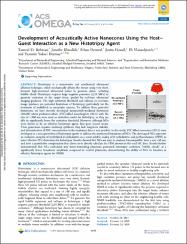Development of acoustically active nanocones using the host-guest interaction as a new histotripsy agent

Göster/
Erişim
info:eu-repo/semantics/openAccessTarih
2019Yazar
Rehman, Tanzeel UrKhirallah, Jennifer
Demirel, Erhan
Howell, Justin
Vlaisavljevich, Eli
Yüksel Durmaz, Yasemin
Üst veri
Tüm öğe kaydını gösterKünye
Rehman, T. U., Khirallah, J., Demirel, E., Howell, J., Vlaisavljevich, E. ve Yüksel Durmaz, Y. (2019). Development of acoustically active nanocones using the host-guest ınteraction as a new histotripsy agent. ACS Omega, 4(2), 4176-4184. https://dx.doi.org/10.1021/acsomega.8b02922Özet
Histotripsy is a noninvasive and nonthermal ultrasound ablation technique, which mechanically ablates the tissues using very short, focused, high-pressured ultrasound pulses to generate dense cavitating bubble cloud. Histotripsy requires large negative pressures (>= 28 MPa) to generate cavitation in the target tissue, guided by real-time ultrasound imaging guidance. The high cavitation threshold and reliance on real-time image guidance are potential limitations of histotripsy, particularly for the treatment of multifocal or metastatic cancers. To address these potential limitations, we have recently developed nanoparticle-mediated histotripsy (NMH) where perfluorocarbon (PFC)-filled nanodroplets (NDs) with the size of similar to 200 nm were used as cavitation nuclei for histotripsy, as they are able to significantly lower the cavitation threshold. However, although NDs were shown to be an effective histotripsy agent, they pose several issues. Their generation requires multistep synthesis, they lack long-term stability, and determination of PFC concentration in the treatment dose is not possible. In this study, PFC-filled nanocones (NCs) were developed as a new generation of histotripsy agents to address the mentioned limitations of NDs. The developed NCs represent an inclusion complex of methylated beta-cyclodextrin as a water-soluble analog of beta-cyclodextrin and perfluorohexane (PFH) as more effective PFC derivatives for histotripsy. Results showed that NCs are easy to produce, biocompatible, have a size <50 nm, and have a quantitative complexation that allows us to directly calculate the PFH amount in the used NC dose. Results further demonstrated that NCs embedded into tissue-mimicking phantoms generated histotripsy cavitation "bubble clouds" at a significantly lower transducer amplitude compared to control phantoms, demonstrating the ability of NCs to function as effective histotripsy agents for NMH.
WoS Q Kategorisi
Q2Scopus Q Kategorisi
Q1Kaynak
ACS OmegaCilt
4Sayı
2Koleksiyonlar
- Makale Koleksiyonu [301]
- Makale Koleksiyonu [78]
- PubMed İndeksli Yayınlar Koleksiyonu [4230]
- Scopus İndeksli Yayınlar Koleksiyonu [6574]
- WoS İndeksli Yayınlar Koleksiyonu [6631]

















